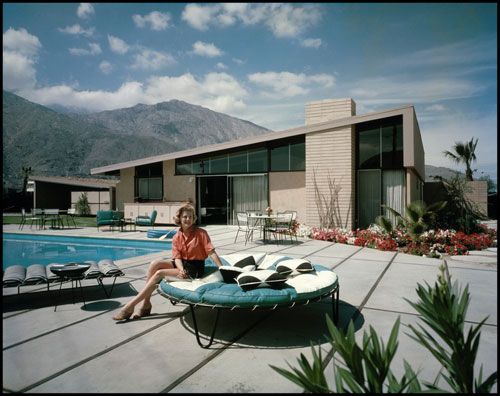
I miss the desert. I miss the quiet and the calm. I miss driving down the 111, feeling the stress of Los Angeles melting away, along with my clothes and inhibitions. The heat was oppressive and comforting all at once. You didn’t have to be bothered. Bothered by neighbors, street noise, traffic or getting dressed. Being in the desert felt like our own tropical island getaway, the antithesis of living our “during the week” lives in Los Angeles.
We were lucky, for a while. We owned a piece of the American dream. A vacation home. I will spare you the agonizing details, since blood, sweat and tears do not mix well with Modernist Architecture. It wasn’t any ordinary weekend box, you see, we had our hands on a genu-whine piece of Mid-Century Modern Creme-de-la-Creme Architecture.
Behold, the Butterfly Alexander.

This home (not the roofline, that conjures the name)was designed by William Krisel for the George Alexander Construction Company in the late 1950’s. It was part of a larger, Modernist, tract of homes in a subdivision known as “Twin Palms”. Krisel, along with partner Dan Palmer, eventually created almost 2,000 similar homes in several subdivisions around Palm Springs. The homes, which sold in 1957 for $19,500, now sell for at least 30 times that price.

Each new construction, with a Butterfly roofline, had a similar floor plan (a flat or slanted roof was also available). The square footage was minimal (1200-1600 sq ft) and designed to be practical with easy access to all areas. Wall partitions in common areas were only 3/4 to encourage air flow and create an open feel. Although the properties looked simple, the devil was in the design details. Floor plans were wide open, construction was post and beam, and the windows were endless.


A patio separated the living areas and entrance to the house from the carport/garage to encourage air flow and offer an inviting entry. Desert landscaping was encouraged for its low maintenance and emphasis was placed on the outdoors.

Each home was built on lots that ranged from 12,000 square feet to several acres. Room enough for the necessary pool, entertainment areas and desert vegetation. Most lots had no fences. Unlike now, most tract housing built in the 50’s and 60’s was designed to bring neighborhoods together with communal areas and open spaces to encourage socialization. The Butterfly roofline was originally designed to capture and re-route rainwater and ward off the often violent desert winds.
But, like many practical designs, this style has become an integral part of modern design and architecture.
Although the the practical and design aspects of this style are important landmarks in and of themselves, nothing compares to the “feeling” of owning and residing in one of these icons of the Mid Century Modern era. Our time with this treasure ended much too quickly, but I will remember it as one of the great experiences of my life. Only a small portion of the originals remain but, with the help of our former friends and neighbors, those that have stood the test of time will remain for generations to come.